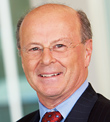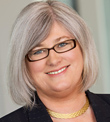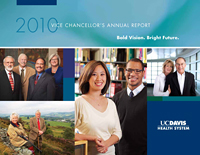
Susan Perez and Leon Cushenberry are first-year students in UC Davis Health System’s Schools of Health, an innovative education model that promotes and facilitates interprofessional training.
Posted March 23, 2011
Although new UC Davis Health System students Susan Perez and Leon Cushenberry are studying different disciplines in health care, they already recognize the value of learning and working as a team.
Perez is one of the inaugural doctoral students at the Betty Irene Moore School of Nursing, while Cushenberry is a first-year medical student. They are both graduates of UC Davis’ neurobiology, physiology and behavior undergraduate program.
Before starting medical school, Cushenberry worked for Scripps Health in San Diego in the pathology department. Perez worked for a community health clinic in Winters where she was project manager for implementation of a digital health record system.
They each worked in cross-functional teams, and those experiences, they say, underscored for them the importance of working together and sharing perspectives to find better solutions.
“We each have knowledge gaps, and by bringing people together with different perspectives, you can bridge those gaps,” Perez says.
Cushenberry agrees: “Working as a team gives each of us the checks and balances that help us arrive at workable, realistic solutions.”
Despite seemingly separate paths, the two students are classmates again at UC Davis Health System’s Schools of Health, an innovative educational model that embraces common values, shared services and administrative efficiencies to promote interprofessional approaches among the medical, nursing, public health and health informatics programs.
Frederick Meyers, executive associate dean of the School of Medicine, and Heather Young, associate vice chancellor for nursing and dean of the new Betty Irene Moore School of Nursing, believe this approach will place the health system at the forefront of the new era of modern health care.
 "The [Schools of Health] concept encourages and enhances coordination and communication, both of strategy — the big picture — and of tactics that will make us more efficient and more effective."
"The [Schools of Health] concept encourages and enhances coordination and communication, both of strategy — the big picture — and of tactics that will make us more efficient and more effective."
— Frederick Meyers
“It’s an exciting model to bring people together,” Meyers says. “It’s about clinical and educational partners, resources and support services working together around shared core values in the schools. This concept encourages and enhances coordination and communication, both of strategy — the big picture — and of tactics that will make us more efficient and more effective.”
The integrated “Schools of Health” concept is gaining a groundswell of support from faculty, staff, stakeholders and the community as a whole. The concept is simple: True interdisciplinary function can be achieved by redesigning the organizational structure of the medical, nursing and public health academic programs.
“It is a basic principle that we teach our students in biochemistry — ‘structure determines function,'” says Meyers. “We are now applying that to our Schools of Health so that we can genuinely become an interprofessional academic health center.”
Achieving population health and addressing the complex challenges posed by common, chronic and costly health conditions such as Alzheimer’s disease, diabetes or asthma require different solutions than those used in the past.
“Say you have a newly diagnosed diabetic mother with young kids who also has a father with Alzheimer’s disease,” Young says, by way of example. “There are a lot of dynamics here: How do we deal with her diabetes? What about her caregiving issues, or her ability to balance work with her health and family issues? Creative solutions for this woman can be generated by an interprofessional team, including nurses, physicians, dietitians, pharmacists and others who all have input about the problems she is facing.”
 "There's a commitment to innovation and entrepreneurial spirit here, the willingness to try new things. If we can collaborate and transcend boundaries, we'll end up with better outcomes for the people we serve."
"There's a commitment to innovation and entrepreneurial spirit here, the willingness to try new things. If we can collaborate and transcend boundaries, we'll end up with better outcomes for the people we serve."
— Heather Young
Few academic health centers have adopted the interprofessional model, and many operate their professional schools independently with separate leadership, administrative support services and academic functions. Duplicative efforts that support a range of health professional programs make less sense during an era in which maximum efficiency is vital. For example, nursing, pharmacy and medical schools all teach pharmacology, Meyers points out.
“Should each school have its own department of pharmacology and hire its own people? What about anatomy or health informatics?”
Thus, the Schools of Health model — in which the professional schools retain their own identities but are united by a strong, collaborative interprofessional ethic — has become the organizational model the health system is adopting.
At its heart, the Schools of Health model builds upon the health system’s already-integrated nature. The medical center, the School of Medicine, the Betty Irene Moore School of Nursing and the public/population health programs report to the vice chancellor for human health sciences. Finance, information technology, diversity and inclusion, government relations and human resources units provide support to all the integrated entities.
In addition, faculty with dual appointments in, for example, informatics and population health are being recruited. These faculty will have appointments in both the nursing and medical schools.
Alignments in education and student support — such as financial aid and the registrar’s offices — are being identified. Plans are under way for a Schools of Health graduate studies building.
An integrated strategic plan is being updated to reflect the new model.
The Clinical and Translational Science Center, established in 2006, has proven to be a natural vehicle for interprofessional and interdisciplinary research. For instance, a Robert Wood Johnson grant unites nurses, psychologists and physical medicine and rehabilitation physicians to define team approaches to chronic pain management.

"Learning together across disciplines" first appeared in the 2010 UC Davis Health System annual report. Click to read more and find out how UC Davis is making far-reaching advances in health care to improve the lives of people in our own communities, across the nation and around the globe.
The new Betty Irene Moore School of Nursing is a significant catalyst for the Schools of Health approach. Its Nursing Science and Health-Care Leadership graduate group is composed of 28 faculty from nursing, medicine, public health, nutrition, informatics and other professions.
The inaugural classes are similarly diverse, with many having backgrounds in public health, informatics and other fields.
The nursing school has an unprecedented opportunity to align to the innovative model from the ground up.
“Our timing is perfect,” Young says. “If we get in sync and connect thoughtfully from the start, we have a huge advantage in making it happen.”
The Schools of Health model is not without its challenges. The complexity of scheduling graduates, nursing and medical students, and faculty is a labyrinth to navigate. Then, too, there’s the dissonance of a lagging cultural shift — such as when students learn teamwork in the classroom, only to encounter a fragmented hierarchal workplace after graduation.
“I don’t know that everybody sees that interprofessional efforts are always going to pay off,” says Meyers. “But we think — and the data supports the idea — that if you’re going to be truly innovative and take big steps forward, you’re going to have to be interdisciplinary. We’re trying to take it to a new level of integration.”
Young agrees. “There’s a commitment to innovation and entrepreneurial spirit here, the willingness to try new things. If we can collaborate and transcend boundaries, we’ll end up with better outcomes for the people we serve. This is an opportunity for UC Davis to really lead the way.”